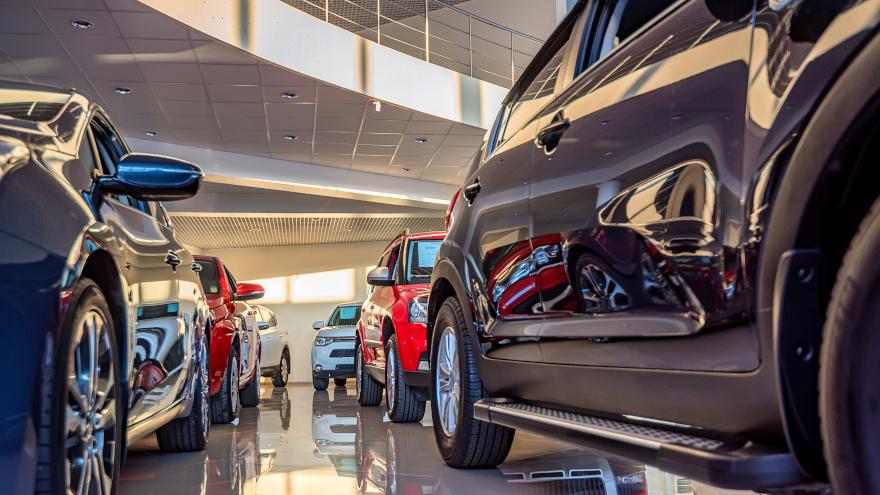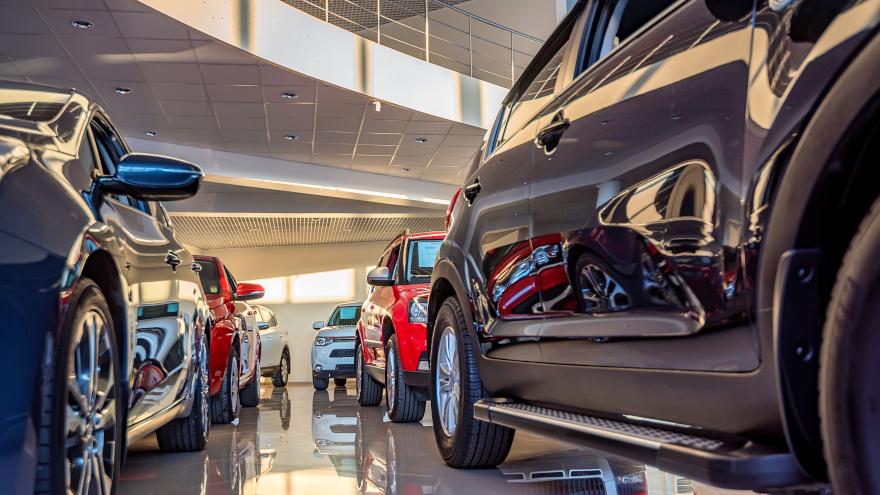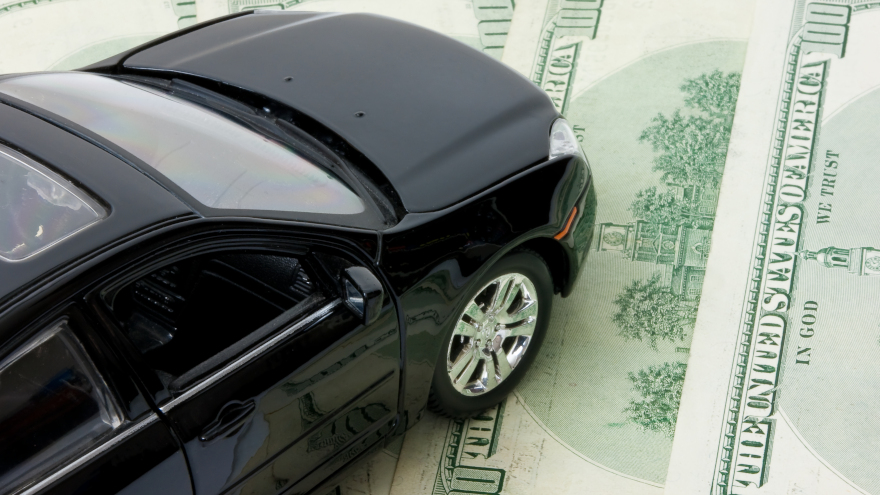Wholesale vehicle prices are on quite a hot streak.
The Manheim Used Vehicle Value Index climbed nearly 16% year-over-year in August and soared to a third straight record month.
Specifically, the index was at 163.7 for the month, up 15.8% from August 2019.
There was a 3.64% rise in wholesale prices (adjusted for mix, mileage and seasonality) from July, according to the Cox Automotive analysis accompanying the index.
August’s record index reading (163.7) beats the prior all-time highs set in July (158.0) and June (149.3), respectively.
The Manheim index wasn’t the only one to set a record in August.
Black Book said last week that its Used Vehicle Retention Index was at an all-time high of 129.0, up 3 points from July and beating year-ago figures by 12.4 points.
“Wholesale prices continued to grow across all segments in August,” Black Book senior vice president of data science Alex Yurchenko said in a news release. “The increases were much smaller than in July, and by the end of the month, prices reached their peak. We expect the weakening of the market in the next several months as the economy remains weak and there is an expected glut of used supply.”
Segment prices
Looking at specific market segments in the Manheim index, pickup prices showed significant growth year-over-year, climbing 23% (compared to the industry total of 15.8%), according to the Cox analysis.
Luxury car prices also showed stronger-than-average growth, as they were up 20%.
SUV/CUV prices were up 13.4%, while compact cars climbed 7.9% and midsize cars were up 7.7%, according to the analysis.
There was a 3.4% uptick in van prices.
On the rental side of the market, there was an 8.4% hike in auction prices for rental-risk units.
Wholesale prices might have hit their apex in August, according to the team at Black Book.
Analysts released their Used Vehicle Retention Index for August, which came in at a new high for the measurement at 129.0. That reading represented a 3.0-point rise from July, but Black Book isn’t expecting the climb to continue.
“Wholesale prices continued to grow across all segments in August,” Black Book senior vice president data science Alex Yurchenko said.
“The increases were much smaller than in July, and by the end of the month, prices reached their peak,” Yurchenko continued. “We expect the weakening of the market in the next several months as the economy remains weak and there is an expected glut of used supply.”
The Black Book Used Vehicle Retention Index is calculated using Black Book’s published wholesale average value on 2- to 6-year-old used vehicles, as a percent of original typically equipped MSRP. It is weighted based on registration volume and adjusted for seasonality, vehicle age, mileage and condition.
The index dates to January 2005 when Black Book published a benchmark index value of 100.0 for the market. During 2008, the index dropped by 14.1% while during 2016, the index fell by just 6.4%. During 2011, the index rose strongly from 113.3 to 123.0 by the end of the year as the economy picked up steam and used vehicle values rose higher.
The index continued to remain relatively stable, rising slightly until May 2014 when it hit the previous peak of 128.1.
To obtain a copy of the latest Black Book Wholesale Value Index, go to this website.
Add auctioneers to the list of professionals from throughout the automotive industry having to put in more effort to overcome challenges created by the coronavirus pandemic.
In the latest installment of COVID-19 Market Insights released by Black Book on Tuesday, analysts described what’s happening in the lanes nowadays as dealers continue to keep a close watch on their inventory and floorplan.
“For the past two weeks, auctioneers have been finding themselves having to work harder to get the bids up,” Black Book said.
“This past week, more bids were resulting in ifs and no-sales as buyers showed hesitancy in stepping up an additional $300 to $400 to meet the sellers’ floors,” analysts continued in the latest report.
That reluctance and awareness about sellers’ floors arrived as Black Book noticed that its volume-weighted information showed overall car segment values increased just 0.04% this past week, representing the lowest week-over-week value increase since the third week of May.
Analysts explained that sub-compacts, compacts and sporty cars each sustained value decreases ranging from 0.13% to 0.36% because of softening retail demand.
Conversely, Black Book noticed the luxury segments are demonstrating value stability, especially premium sports cars that gained 0.55% week-over-week.
Over on the truck side, analysts indicated their volume-weighted information showed overall truck segment values (including pickups, SUVs and vans) rose by 0.41% last week.
Black Book pointed out the upward value march for full-size trucks continued into the 14th week in a row.
“New-inventory deliveries are starting to increase after months of struggles to get production back going, so it is expected that this rate of increase will begin to slow,” analysts said.
And speaking of those new models, their arrival at franchised dealerships is also prompting managers to be “more selective in the used units they are sourcing at auction and the trade-ins they are keeping,” according to Black Book.
Analysts then added, “This past week, dealers backed off in their purchasing with the reason being that they want to wait to see how consumer demand shapes up over the Labor Day weekend.”
Black Book touched on one other ongoing difficulty that’s intensified since March and how the industry is trying to use technology to solve the issue.
“With transportation continuing to present a challenge for buyers and sellers due to the time and cost required to move vehicles, some sellers are making use of the virtual sales by listing their vehicles for sale but vehicle pickup is at their dealership or another holding location,” analysts said.
“This is beneficial to sellers because it is allowing them to get their units offered for sale sooner,” they went on to say.
Driven by climbing pre-owned demand and short new-car supply, retail used-vehicle prices in the first half of August had climbed 4.1% month-over-month, according to an iSeeCars.com analysis.
Similarly, J.D. Power’s used retail price index was at 107.2 the week ending Aug. 23, up from 106.8 the prior week and continuing a long pattern of growth.
Used retail prices are up about 7% from where they were before the pandemic, J.D. Power said.
But as iSeeCars shows in its analysis, the shift in used retail prices is not entirely uniform, as some segments and specific models bucked the trend either direction.
For instance, sports cars and luxury cars had stronger-than-average price gains, iSeeCars found. Prices for economy cars and sedans were down in August.
“Dealers don’t need to be as competitive with the pricing of luxury and higher-priced vehicles because shoppers at these price points likely aren’t as bargain-conscious as those looking for more affordable and practical used cars,” iSeeCars chief executive Phong Ly said in an analysis.
“Subcompact cars are the lowest-priced used cars available, so it’s likely that shoppers interested in these vehicles are looking for a deal,” he said.
Breaking the variance down further, iSeeCars shared the 10 used-vehicle models with the greatest price growth (percentage-wise) from July to August as well as the 10 with the largest price drops.
The iSeeCars study included more than 500,000 sales of 2015 to 2019 model-year vehicles between July 1-17, and then more than 400,000 of that same age group from Aug. 1-17.
As illustrated in the charts below, topping the list of highest price increases was the Dodge Challenger, whose used-vehicle prices were up 9% from July to August.
Aside from the Ford Mustang (up 7.2%) at No. 9, luxury models filled the rest of the list.
“The Ford Mustang and the Dodge Challenger are the best-selling sports cars in the United States, and used-car shoppers are willing to pay a premium for these in-demand vehicles,” said Ly.
As for the luxury vehicles on the list, he added: “Consumers are likely drawn to the prestige of these vehicles and may be less price sensitive even though Land Rovers are notorious for below-average reliability scores and high ownership costs, and BMWs and Volvos have above average ownership costs as well.”
Conversely, the list of vehicles with the biggest price declines is led by the Chevrolet Sonic, whose prices were down 2.3% month-over-month. The rest of the list includes a variety of segments, but overall, midsize sedans claim four of the 10 spots, the iSeeCars data shows.
“The declining popularity of the segment and the emergence of more affordable small SUVs have lessened the demand for these sedans, so dealers are more likely to provide discounts,” said Ly.
The iSeeCars charts on the 10 used vehicles with biggest price gains and biggest price drops can be found below.
| Used Vehicles With the Greatest Price Increases – iSeeCars Study |
| Rank |
Used Vehicle |
Average Used Car Price (August 2020) |
$ Price Difference from July to August |
% Price Difference from July to August |
| 1 |
Dodge Challenger |
$32,163 |
$2,667 |
9.0% |
| 2 |
Land Rover Range Rover Sport |
$51,502 |
$4,226 |
8.9% |
| 3 |
Volvo S60 |
$23,105 |
$1,829 |
8.6% |
| 4 |
Lexus RX 350 |
$35,055 |
$2,707 |
8.4% |
| 5 |
Land Rover Discovery Sport |
$28,839 |
$2,121 |
7.9% |
| 6 |
BMW 4 Series |
$28,064 |
$2,050 |
7.9% |
| 7 |
BMW 7 Series |
$45,213 |
$3,209 |
7.6% |
| 8 |
Volvo XC60 |
$29,011 |
$2,042 |
7.6% |
| 9 |
Ford Mustang |
$28,715 |
$1,940 |
7.2% |
| 10 |
Land Rover Range Rover Evoque |
$29,866 |
$1,961 |
7.0% |
| Average |
$23,705 |
$941 |
4.1% |
| Used Vehicles With the Greatest Price Decreases – iSeeCars Study |
| Rank |
Used Vehicle |
Average Used Car Price (August 2020) |
$ Price Difference from July to August |
% Price Difference from July to August |
| 1 |
Chevrolet Sonic |
$10,463 |
-$243 |
-2.3% |
| 2 |
GMC Yukon XL |
$42,317 |
-$811 |
-1.9% |
| 3 |
Chevrolet Spark |
$9,839 |
-$185 |
-1.8% |
| 4 |
Ford Fusion Energi |
$16,844 |
-$313 |
-1.8% |
| 5 |
Ford Ecosport |
$17,409 |
-$199 |
-1.1% |
| 6 |
Mazda Mazda6 |
$16,704 |
-$188 |
-1.1% |
| 7 |
Porsche 911 |
$132,704 |
-$1,453 |
-1.1% |
| 8 |
Hyundai Elantra GT |
$13,906 |
-$150 |
-1.1% |
| 9 |
Lincoln MKZ |
$22,513 |
-$241 |
-1.1% |
| 10 |
Nissan Altima |
$15,339 |
-$124 |
-0.8% |
| Average |
$23,705 |
$941 |
4.1% |
KAR Global shared its July wholesale price data on Thursday, reiterating how the coronavirus pandemic is making its metrics unusual compared to what dealers and consignors typically see during the summertime.
According to KAR Global Analytical Services’ monthly analysis of wholesale used vehicle prices by vehicle model class, wholesale prices in July averaged $13,375, representing a 2.6% increase compared to June and an 18.0% gain compared to the pre-COVID-19 reading back in February.
KAR chief economist Tom Kontos also noted the July figure marked a 16.8% jump relative to the same month last year.
“The rate of increase in average wholesale prices slowed a bit in July but still represented substantial gains over pre-COVID and year-ago levels,” he said in his latest installment of the Kontos Kommentary.
“As we’ve emphasized in past editions, part of this increase is due to selling a more limited quantity and higher average quality (age, mileage, condition, size, etc.) of vehicles,” Kontos continued.
“But dealer demand, which reflects consumer demand, for used vehicles is also a key driver to higher prices. These relatively strong market conditions continued into August,” he went on to say.
When holding constant for sale type, model-year-age, mileage, and model class segment — using criteria that characterize off-lease units — Kontos also said prices rose on a year-over-year basis for midsize cars and midsize SUV/CUVs in July.
Prices for those particular cars spiked $1,186 or 9.4% year-over-year to land at $13,856, according to KAR, which also pointed out that prices for those specific SUVs and CUVs climbed $637 or 3.0% compared to a year ago to come in at $22,162.
KAR Global Wholesale Used-Vehicle Price Trends
| |
Average |
Price |
|
($/Unit) |
Latest |
Month |
Versus |
| |
July 2020 |
June 2020 |
February 2020 |
July 2019 |
Prior Month |
Pre-COVID-19 |
Prior Year |
| |
|
|
|
|
|
|
|
| Total All Vehicles |
$13,375 |
$13,033 |
$11,338 |
$11,452 |
2.6% |
18.0% |
16.8% |
| |
|
|
|
|
|
|
|
| Total Cars |
$9.944 |
$9,600 |
$8,361 |
$8,654 |
3.6% |
18.9% |
14.9% |
| Compact Car |
$7.567 |
$7,167 |
$6,535 |
$6,609 |
5.6% |
15.8% |
14.5% |
| Midsize Car |
$8,604 |
$8,294 |
$7,317 |
$7,444 |
3.7% |
17.6% |
15.6% |
| Full-size Car |
$9,192 |
$9,304 |
$7,765 |
$7,886 |
-1.2% |
18.4% |
16.6% |
| Luxury Car |
$15,793 |
$15,269 |
$12.659 |
$13,347 |
3.4% |
24.8% |
18.3% |
| Sporty Car |
$17,657 |
$16,712 |
$13,874 |
$14,673 |
5.7% |
27.3% |
20.3% |
| |
|
|
|
|
|
|
|
| Total Trucks |
$15,742 |
$15,327 |
$13,529 |
$13,618 |
2.7% |
16.4% |
15.6% |
| Minivan |
$9,188 |
$9,193 |
$8,286 |
$8,404 |
-0.1% |
10.9% |
9.3% |
| Full-size Van |
$14,262 |
$13,234 |
$13,182 |
$13,082 |
7.8% |
8.2% |
9.0% |
| Compact SUV/CUV |
$12,195 |
$11,829 |
$10,487 |
$11,173 |
3.1% |
16.3% |
9.1% |
| Midsize SUV/CUV |
$14,874 |
$14,409 |
$12.762 |
$11,774 |
3.2% |
16.5% |
26.3% |
| Full-size SUV/CUV |
$16,725 |
$12,794 |
$16,352 |
$15,482 |
30.7% |
2.3% |
8.0% |
| Luxury SUV/CUV |
$21,730 |
$21,453 |
$18,714 |
$18,839 |
1.3% |
16.1% |
15.3% |
| Compact Pickup |
$14,076 |
$13,006 |
$11,268 |
$11,345 |
8.2% |
24.9% |
24.1% |
| Full-size Pickup |
$20,393 |
$19,013 |
$16,385 |
$17,479 |
7.3% |
24.5% |
16.7% |
Source: KAR Global Analytical Services.
Wholesale vehicle prices are on pace for a third straight month of record highs, according to a mid-month update of the Manheim Used Vehicle Value Index.
After the first 15 days of August, the index was at 163.4, which is up 15.6% from mid-August 2019.
The Manheim index finished July at a record high of 158.0, beating prior-year figures by 12.5% and the previous record set in June (149.3) by nearly nine points.
As far as the current month, wholesale prices in the first half were up 3.4% from July, parent company Cox Automotive said in an analysis accompanying the index.
That said, the price gains have slowed a bit.
“Manheim Market Report (MMR) prices improved again over the last two weeks, resulting in a 1.4% cumulative increase in the first two weeks of August on the Three-Year-Old Index,” analysts said. “Over the first 15 days of August, MMR Retention, which is the average difference in price relative to current MMR, was at or above 99.8% every day and averaged 101.0%. Price appreciation has been slowing in recent weeks.”
Among the select segments shared in the Manheim data, pickup truck prices in mid-August were up 22.5% from where they were in mid-August 2019.
Luxury cars weren’t far behind (up 20.9%), followed by SUV/CUVs (up 12.6%). Compact car values climbed 8.1%, midsize cars were up 8.2% and vans were up 2.9%.
In a related analysis, J.D. Power found that wholesale prices during the first full week of August were up 0.8 percentage points. The company’s Weekly Wholesale Auction Price Index was at 114.8 for the week ending Aug. 9, which was the 16th straight time wholesale prices had climbed week-over-week.
That streak of sequential price gains ended last week, as prices for the week ending Sunday were even with the prior week, J.D. Power said in an update Wednesday.
“However, prices have increased 36% since their trough in April and are 15% higher than the beginning of March. Wholesale prices remain strong, but the used market is slowing,” J.D. Power said in Wednesday's update.
“Prices are expected to continue to level off in August as pent-up demand wanes and pandemic-related macro-economic headwinds increase. By year's end, prices are expected to be slightly greater than pre-virus levels,” the company said. “It is important to note, however, that while the outlook is relatively optimistic, there remains a great deal of uncertainty surrounding the impact of new virus outbreaks, the potential for another round of federal stimulus, and overall employment conditions.
“Given these unknowns, a heightened degree of market volatility should be expected.”
Perhaps nowadays more than ever, open sales might be the best path for consignors to fetch the highest amounts for their vehicles going through the wholesale market.
Black Book described the ongoing scene in its latest COVID-19 Market Insights released on Tuesday that included a mention of how both car and truck values moved higher for the 12th consecutive week.
According to their volume-weighted data, Black Book analysts said overall car and truck segments both showed gains for what’s basically been the past three months, increasing 0.82% overall this past week. While still higher, the increase wasn’t quite as robust as the prior week when it was 1.08%.
What’s keeping values on that upward march? At least a portion of the push is any kind of licensed dealer trolling the lanes for inventory.
“The open auction environment is the place to be with sellers reporting strong success when they are able to get their vehicles into a competitive bidding environment,” Black Book said in the latest report. “Sellers are enjoying the competition that is happening between the big buyers like CarMax, Carvana, and Vroom.
“Auctions have always had a competitive nature, but in this supply-stricken market, the competition has been taken to a new level,” Black Book continued. “Some sellers are now only wanting their vehicles to be offered for sale in the open bidding environment as they are finding this is warranting a higher success rate and increased dollar value compared to upstream sales channels.”
Whether that consignor has compact sedans or full-size pickups, values for those units are rising, although momentum is decelerating a bit in the car space.
Again based on volume-weighted information, Black Book indicated overall car segment values rose 0.65% this past week, marking the lowest amount of increase since the second week of June when the values first began large week-over-week increases.
Analysts pointed out the highest-volume car segment — those previously mentioned compact cars — slowed down in appreciation this past week as the latest increase came in at 0.57%. That reading is less than half the previous week’s jump, which was 1.21%
When volume-weighting is applied, Black Book computed that overall truck segment values — including pickups, SUVs and vans — climbed by 0.91% last week. That figure more resembled the previous week’s rise of 1.10%.
Black Book noted full-size trucks continued their ascent with an increase this past week of 1.48%; the largest increase of all vehicle segments.
“The lack of available new inventory is a big driver of this increased demand for used full-size trucks,” analysts said.
“New inventory deliveries are increasing, but not at a fast-enough pace, especially when it comes to full-size pickups and crossovers/SUVs,” analysts continued later in the report. “The demand for these units continues to be strong on the lanes, with bidding activity pushing the values higher and higher each week.
“Remarketers continue to push their luck by raising floors each week and buyers are stepping up to be the successful buyer,” Black Book went on to say.
Black Book mentioned one other element that’s become more prominent with the auction world so much different now than it was a year ago.
“With complaints around condition reporting accuracy continuing to be a commonality, a seller’s reputation is more important than ever,” analysts said. “Sellers with a solid reputation for offering quality used units have an advantage with buyers now willing to step up in price on units from a trusted seller.”
KAR Global chief economist Tom Kontos returned to the Auto Remarketing Podcast to discuss how much off-rental units might impact wholesale volume and pricing as turbulent 2020 continues.
Kontos also touched on other factors that he and his team are watching that could influence both the wholesale and retail markets going forward.
To listen to this episode, click on the link available below, or visit the Auto Remarketing Podcast page.
Download and subscribe to the Auto Remarketing Podcast on iTunes or on Google Play.
While the acceleration of wholesale prices moving higher dipped a bit, Black Book indicated dealerships with the most robust financial resources continue to have the best opportunity to secure used-vehicle inventory during the coronavirus pandemic.
Black Book specifically mentioned large operations such as CarMax and Carvana showing their “dominance in the lanes” as analysts released their latest COVID-19 Market Insights report earlier this week.
“The increase in pricing related to winning bids is forcing smaller buyers to step back from bidding for fear of getting stuck with high-priced inventory,” Black Book said in the report.
“The divide continues to grow between the smaller dealers and the larger outfits as the money required to purchase inventory increases and retail fails to increase at the same pace,” analysts continued. “The larger dealers are relying on financing and add-on services as a revenue stream to overcome the small retail margins, but this is hurting the smaller dealers that do not have these services to offer.”
No matter who is cutting the floorplan checks, the amount needed to get those vehicles is declining at least a little bit.
Based on its volume-weighted data, Black Book reported that overall car segment values increased 0.96% this past week, representing the smallest amount of upward movement in the past seven weeks when prices first started a rapid week-over-week run of increases.
Analysts pointed out the latest movement is in sharp contrast to the same week last year when overall car segments values decreased 0.27%.
When volume-weighting is applied, Black Book determined overall truck segment values (including pickups, SUVs and vans) increased by 1.04% last week, marking the first time during the rebounding of values that the increases in the truck space exceeded the car arena.
“Last week, the minivan and full-size van segments had small declines that were viewed as stability, but the stability didn’t last long with all segments once again increasing this past week,” analysts said. “However, it is notable that many were at a smaller pace than previous weeks.”
Turning back to the atmosphere in the lanes nowadays, Black Book mentioned another trend that might be making it more challenging for dealerships with less financial horsepower to secure inventory they want.
“The portion of the market that is showing some stabilization and a slight softening are the ‘edgier’ units — those with higher mileage and lower condition scores,” analysts said.
“At the onset of the pandemic, the lower price point of these vehicles made them desirable, but this is a portion of the market that is showing some stability now,” they continued.
“The demand has shifted now toward newer-model-year, lower-mileage, and clean condition units that provide a viable substitution for consumers that are in the market for a new vehicle,” Black Book went on to say.
Black Book wrapped up its latest observations with two other anecdotes.
“Last week values continued to rise, but we did experience a small increase in no-sales as sellers continue to raise their floors and buyers show some hesitancy around what the future holds for used cars,” analysts said.
“Auction volume is showing some regionality in trends with volume increasing, particularly of rental units, in portions of the country that have been harder hit by spikes in COVID-19 cases,” they continued.
“Additionally, in the past two weeks, we’ve seen pockets of damaged units being sold in various parts of the country with sellers taking advantage of the strong market for late-model vehicles,” Black Book concluded.
Records continue to tumble in the wholesale market.
Black Book reported on Monday that the month-over-month increase of its Used Vehicle Retention Index established another record as the July reading came in at 126.0, representing a 10.9-point lift from the June level of 115.1.
“July’s growth in the Retention Index broke the month-over-month increase record set just a month earlier,” said Alex Yurchenko, senior vice president of data science at Black Book. “Wholesale prices showed tremendous strength for the second month in a row due to shortages of used and new inventory, together with a strong demand fueled by the first round of federal stimulus payments.”
The Black Book Used Vehicle Retention Index is calculated using Black Book’s published wholesale average value on 2- to 6-year-old used vehicles, as a percent of original typically equipped MSRP. It is weighted based on registration volume and adjusted for seasonality, vehicle age, mileage and condition.
The index dates to January 2005 when Black Book published a benchmark index value of 100.0 for the market. During 2008, the index dropped by 14.1% while during 2016, the index fell by just 6.4%.
During 2011, the index rose strongly from 113.3 to 123.0 by the end of the year as the economy picked up steam and used vehicle values rose higher. It continued to remain relatively stable, rising slightly until May of 2014 when it hit a peak of 128.1.
To obtain a copy of the latest Black Book Wholesale Value Index, go to this website.












